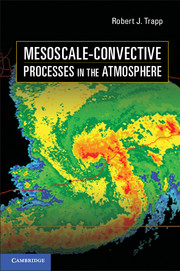Book contents
- Frontmatter
- Contents
- Preface
- 1 The Atmospheric Mesoscale
- 2 Theoretical Foundations
- 3 Observations and Mesoscale Data Analysis
- 4 Mesoscale Numerical Modeling
- 5 The Initiation of Deep Convective Clouds
- 6 Elemental Convective Processes
- 7 Supercells
- 8 Mesoscale Convective Systems
- 9 Interactions and Feedbacks
- 10 Mesoscale Predictability and Prediction
- References
- Index
- Plate section
6 - Elemental Convective Processes
Published online by Cambridge University Press: 05 March 2013
- Frontmatter
- Contents
- Preface
- 1 The Atmospheric Mesoscale
- 2 Theoretical Foundations
- 3 Observations and Mesoscale Data Analysis
- 4 Mesoscale Numerical Modeling
- 5 The Initiation of Deep Convective Clouds
- 6 Elemental Convective Processes
- 7 Supercells
- 8 Mesoscale Convective Systems
- 9 Interactions and Feedbacks
- 10 Mesoscale Predictability and Prediction
- References
- Index
- Plate section
Summary
Synopsis: Upon initiation, deep convective clouds may evolve into precipitating convective storms. The elemental storm processes are updrafts and downdrafts. Their dynamical structure is described in this chapter, as is that of the storm outflow, to which the updrafts and downdrafts are intimately linked. Consideration is then given to storm evolution, in the context of the single- and multicelled storms of lowest hierarchical rank.
Overview of the Convective Storm Spectrum
Once initiated, convective clouds may evolve into deep convective storms that produce precipitation at the ground, gusty surface winds, and sometimes hail, lightning, and tornadoes. The duration, intensity, and types of phenomena attendant to the storm are related largely to the storm morphology or convective mode. Observable structural characteristics can be used to classify storms as:
Discrete, unicellular storms, including supercell storms
Multicellular storms
Mesoscale-convective systems (MCSs)
This classification – which is well supported by weather radar and satellite observations – borrows from the biological sciences, with convective cells regarded as the basic building blocks of convective storms. A convective cell has a definite, yet porous, boundary (visible cloud edge) like a biological cell wall. A convective cell may also divide and split into two cells (a splitting supercell), encounter and merge with other cells to become a larger cell (an MCS), have more than one “nucleus” (a multicell), and decay or grow depending on the availability of “nutrients” such as atmospheric moisture in its environment.
- Type
- Chapter
- Information
- Mesoscale-Convective Processes in the Atmosphere , pp. 162 - 194Publisher: Cambridge University PressPrint publication year: 2013

